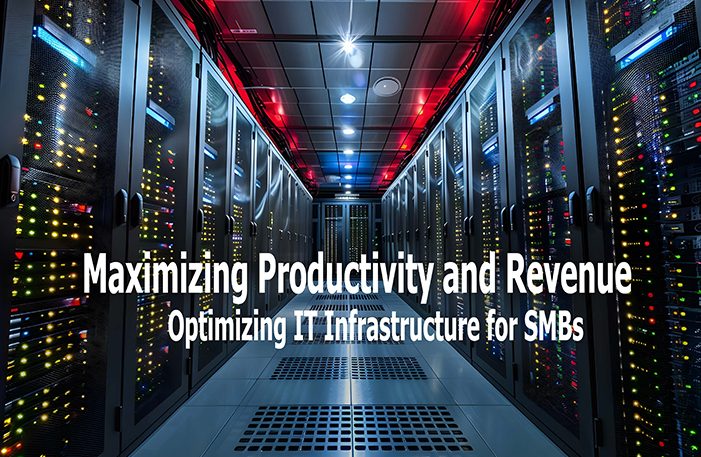In the fast-paced world of small to mid-size businesses (SMBs), optimizing IT infrastructure is not just about staying competitive—it’s about driving productivity and revenue growth. With the right strategies in place, SMBs can leverage technology to streamline operations, enhance efficiency, and unlock new revenue streams. In this blog, we’ll explore practical tips and best practices for optimizing IT infrastructure to maximize productivity and revenue.
- Embrace Cloud Computing: Cloud computing offers SMBs a wealth of benefits, including scalability, flexibility, and cost-efficiency. By migrating IT operations to the cloud, businesses can reduce reliance on physical hardware, minimize upfront costs, and access resources on-demand. Whether it’s leveraging Software-as-a-Service (SaaS) applications for enhanced collaboration or adopting Infrastructure-as-a-Service (IaaS) for scalable computing power, embracing cloud computing can significantly improve productivity and agility.
- Prioritize Cybersecurity: In an era of increasing cyber threats, safeguarding sensitive data and protecting against security breaches is paramount for SMBs. Implement robust cybersecurity measures, including firewalls, antivirus software, encryption, and regular security audits. Educate employees about cybersecurity best practices and enforce strict access controls to prevent unauthorized access to critical systems and data. By prioritizing cybersecurity, SMBs can mitigate risks, build trust with customers, and safeguard their reputation.
- Leverage Automation: Automation has the power to revolutionize business processes, driving efficiency and productivity gains across the board. Identify repetitive tasks and processes that can be automated, such as data entry, invoicing, and inventory management. Implement workflow automation tools and robotic process automation (RPA) solutions to streamline operations, reduce manual errors, and free up valuable time for employees to focus on strategic initiatives. By embracing automation, SMBs can optimize resource allocation and accelerate business growth.
- Implement Scalable Infrastructure: As SMBs grow and evolve, their IT infrastructure needs to scale accordingly. Invest in scalable infrastructure solutions that can accommodate changing business requirements and future growth. Whether it’s upgrading hardware components, expanding storage capacity, or migrating to cloud-based platforms, prioritize scalability to avoid bottlenecks and ensure seamless operations as your business expands. Scalable infrastructure empowers SMBs to adapt to market dynamics, seize new opportunities, and drive revenue growth.
- Foster Collaboration and Communication: Effective collaboration and communication are essential for driving productivity and innovation within SMBs. Implement collaboration tools such as project management software, video conferencing platforms, and instant messaging applications to facilitate seamless communication and collaboration among remote teams. Encourage a culture of knowledge sharing, teamwork, and open communication to foster creativity, accelerate decision-making, and drive business success.
Conclusion
In today’s competitive landscape, SMBs must optimize their IT infrastructure to drive productivity and revenue growth. At LAK Technology, we understand the critical role technology plays in achieving these goals.
Our expertise lies in helping SMBs embrace cloud computing, prioritize cybersecurity, leverage automation, implement scalable infrastructure, and foster collaboration. By tailoring solutions to your unique needs, we empower you to unlock your full potential and gain a competitive edge.
Partnering with LAK Technology ensures that your IT infrastructure becomes a catalyst for growth, innovation, and success. Let us guide you in optimizing your IT infrastructure to maximize productivity and revenue, paving the way for sustained success in the digital economy.
LAK Technology is a Minnesota based IT Solutions with a goal to help local small to mid-size businesses to achieve their digital transformation goals and accelerate. Choose LAK Technology as your ally in the digital age, and together, let’s navigate towards a brighter future.



